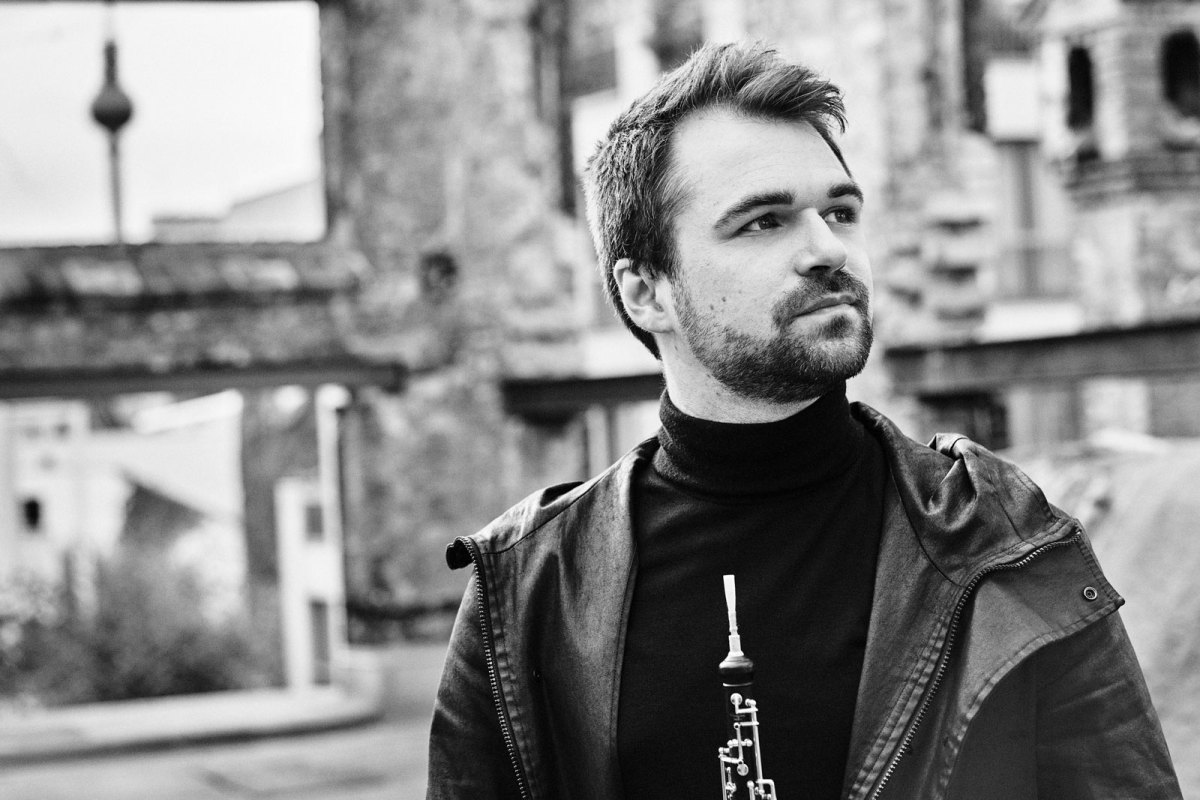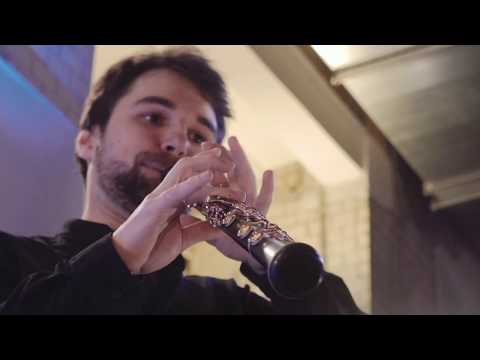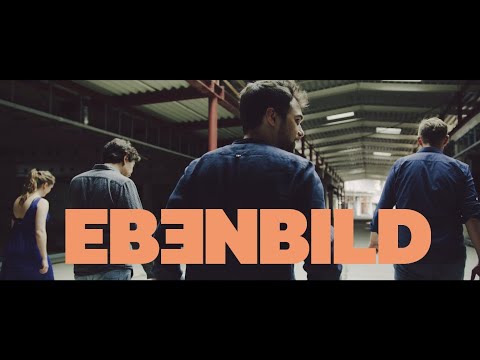The 29-year-old German oboist Juri Vallentin constructed his Berlin Prize for Young Artists program around a climactic scene from Patrick Süskind’s novel Perfume, adding theatrical elements taken from our common experience of loneliness during the COVID-19 pandemic. The program, titled “Inner Voices,” made Vallentin one of two winners of the competition, alongside cellist Valerie Fritz.
Vallentin’s literal inner voice was heard in the program’s central work, “Cardiophonie” by Swiss composer Heinz Holliger. Vallentin’s heartbeat was amplified and served as a kind of metronome for the performance, his pulse increasing jaggedly as the virtuosity of the music took its corporeal toll; the work ended in a moment of self-destructive climax. In this, Holliger’s 1971 composition had a common element with the concert etude “Boulevard des Capucines,” by Gilles Silvestrini, where endless 32-note runs and circular breathing also pushed the performer to the limits of the physically possible. Vallentin’s dramaturgy blended theater with music old and new, combining styles into a cohesive whole.
I met the oboist during a brief break in his busy schedule (he’d just come from a rehearsal for a children’s concert). Still, Vallentin seemed relaxed, talking to me about his pursuit of interaction with the audience, the artistic side of math, and why he’s never playing another competition.
VAN: You almost became a mathematician instead of an oboist. Where do those dual passions come from?
Juri Vallentin: My parents are scientists, so that’s where my passion for math comes from. I’m not from a family of musicians, though we did go to concerts together. Early on, as a child, I knew I wanted to learn the oboe and not another instrument. Looking back, I can’t explain it, but by age six, I knew: The oboe is for me.
Did you ever feel like you faced challenges because you weren’t from a musical family, when you wanted to start working in the industry?
Of course there are advantages when your parents are musicians. You have easier access to good teachers. In my case, I just got lucky. I never went around to all the conservatories, taking lessons and meeting professors, because I didn’t know that’s what was done. It was by chance that I got to know the professor who later became my teacher—a lucky coincidence. At the same time, there was a lot less pressure on me than on someone whose father is the concertmaster of an orchestra. I always had the option of going to study math, and for a long time, I valued the two things equally. On the one hand, there’s a certain split you feel—there were times where I’d had enough, and wanted to quit conservatory. On the other, it does take the pressure off, because I always knew there was a different possible path.
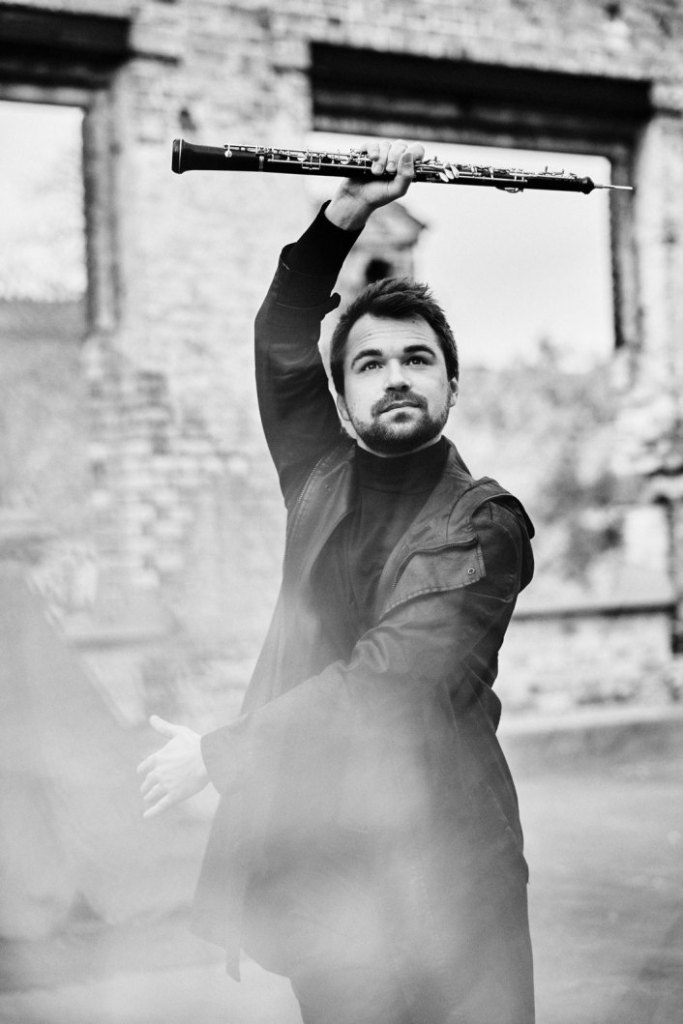
Is math still a part of your life?
I think I’m a very analytical person. Ideas and systems with clear structures appeal to me. But I also think that people tend to misunderstand math as a discipline. It’s an extremely creative field. It’s not about dully repeating experiments or something, but about using the pure power of thought to go in new directions, to explain or prove something. Hot take, but I’d even say that it can be more creative than studying music. And this way of thinking is enriching for all kinds of artistic work. Concentration, too: never saying too much, but always as much as necessary, and as little as possible.
A minor example: It was really useful when preparing Holliger’s piece “Cardiophonie,” where you have to tinker with your heartbeat, the software, and the electronics, so that it works convincingly.
Since you mention Holliger, how did your program for the Berlin Prize come about?
The idea for “Inner Voices” was to understand an instrumental recital as a unified performance: like a real work of music theater, with elements like sound, image, and movement in the space. I wanted to get away from the traditional order of, “Piece, piece, piece, bye.” The most important element of that was the communication with the audience. And I don’t just mean talking between pieces, but: What are ways of creating exchange? For example, in Berio’s “Sequenza VII,” the audience is supposed to sing a note throughout the entire piece. During the performance, I moved around the space. Or theatrical questions, like: How does a particular facial expression affect the audience? What happens when, in “Cardiophonie,” I fall to the ground, and suddenly everything is silent? I also noticed how hard it is to move on stage as soon as I put down my instrument. As classical musicians, we’re just not used to this.
I worked on these aspects of the performance with director Neil Barry Moss. When the competition was announced, in the first phase of the pandemic, he was doing a staging of “Das Rheingold” in the parking lot of the Deutsche Oper in Berlin. It was the first opera production after the silence, and he dealt a lot with the topic of loneliness, and what being shut in meant for all of us.
Did you have specific expectations from the audience, in terms of what you hoped it would give back? Were those expectations met?
It worked really well. Of course, at the end of the day, you never know exactly what’s going to happen, but that’s the appeal of it. As an artist, there’s this fear, which you might pick up during your education, that comes with interacting with the audience in an unexpected way. But the audience wants to be brought along, and it always works out better than you think. When I go to a concert, I want to come out of it one experience richer, so when I’m performing, I try to go beyond the expectations of the audience. That’s why I’m not interested in a program where I just try to play a Bach Oboe Concerto like a studio recording, when there’s hundreds of recordings of just that. I want it to have a special coloring, or a twist: “Ah, I haven’t seen it done like that before.”
At the same time, it’s important for me to bring everyone along. It shouldn’t be deconstructed to the extent that no one gets it. In my opinion, that’s a common problem in Western art music after 1950.
Was there a specific moment that made you want to leave the conventional concert format behind?
A little background first: In the last several years there’s been a lot of talk about the crisis in classical music. There are different ways of seeing that. But right now we’re in a situation where we know that audiences won’t be coming back in the same numbers as before the pandemic. In my opinion, the pandemic had a catalyzing effect: Some things are happening faster now, but they started happening much earlier. That’s why it’s more important than ever to work on timely ways of presenting classical music. I also think it’s important that as an artist you have a profile, a way of being identified, and that you’re not just a replaceable figure who serves to bring the work of the great composer to the stage.
For me personally, what helped was looking to the other arts. Music theater is an obvious one, but the visual arts are also much further than we are in classical music, in some ways. Of course audiences love Caravaggio and Rembrandt. But at the same time, there are so many contemporary artists who thrill large audiences. Recently, I went to the new Yayoi Kusama exhibition in Berlin. All the tickets for the entire week were sold out in 15 minutes. I was using two phones to try and get tickets, and it worked out. It was radical, contemporary–but also utterly beautiful. I’m certain that music is capable of that as well. And I think there’s a lot from that world which us musicians can integrate into our own work.
I feel like the visual arts are more comfortable with the juxtaposition of old and new, whereas classical music tends to focus on categories.
And that’s the next problem: the presentation of new music, and what music is considered part of that category in the first place. The traditional new music concert can be exciting, but it only works for an audience of experts, and that is an insanely small audience. If we want to reach more people, especially younger people—which, I think, has to be our goal—then you need to combine: the known with the unknown. Which the visual arts do often.
Obviously, in the visual arts there’s more courage to try out new things and go in new directions. That’s my call to the classical music scene, to concert promoters and festival organizers: Have more courage, give new currents space. Otherwise, we won’t progress as a scene.
You’ve played in–and won–many competitions. [Among other prizes, Vallentin was the winner of the 2017 German Music Competition, and, in 2019, the first oboist ever to win the International Tchaikovsky Competition.–Ed.] What was your motivation for applying to the Berlin Prize, which was brand new?
It might’ve been new, but it was also completely different from all the others. Sure, the big competitions were essential for my personal path, because they brought me really far on my instrument. I needed to have those goals. And of course, for a young artist, it’s a way of getting attention, which doesn’t just happen. But because of the way the competitions are set up, there’s this need to achieve a certain invincibility: You have to convince the majority of the jury, so you can’t be too polarizing. Once you’ve gotten some experience, you can make strategic decisions with that in mind, to fulfill the jury’s expectations.
For the BPFYA, I needed to play just as well technically, but it wasn’t about fulfilling expectations. The exact opposite was important: surprise. I had planned for the Tchaikovsky competition to be my last, but this blank page, this opportunity to approach it without any rules or expectations, was so interesting to me, that I thought: “Yeah, I’ll do this one too.”
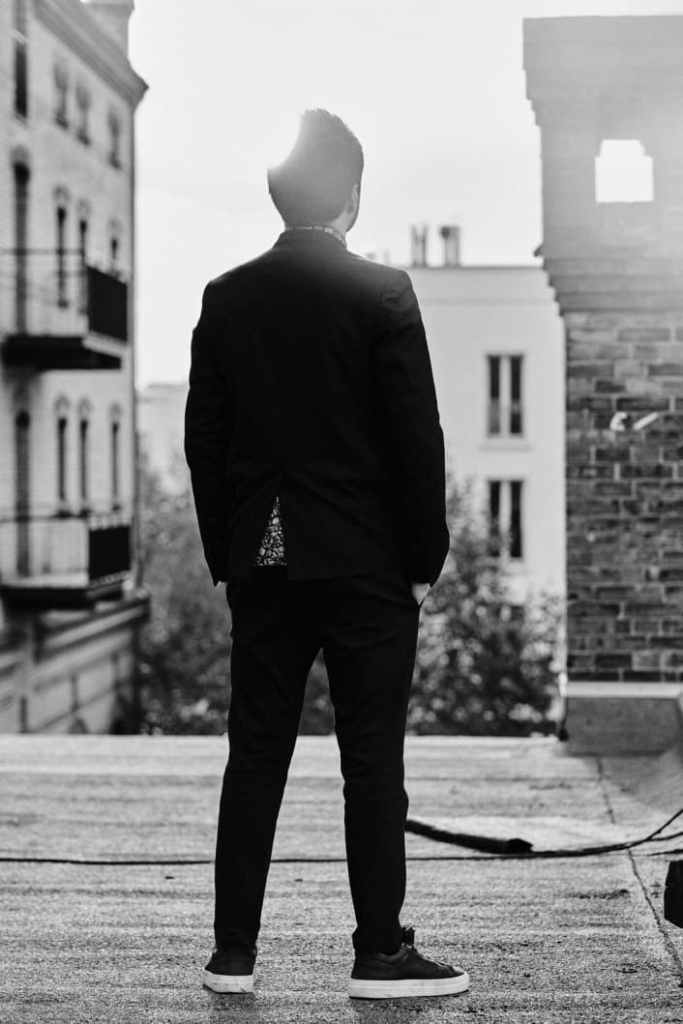
But now you’re done with competitions?
Yeah. This was exactly the right moment for me to let it all go. The pandemic was a turning point for me. Because of all the time I had to devote to purely conceptual ideas, I realized that it’s the authentic choice for me to continue in this direction, and to keep my eye on the other arts. Recently I recorded an album with the string trio Trio d’Iroise and an actress, which is coming out in January. It’s about the connection between literature and music, and the whole CD is centered around a baroque poem. I want to focus on my energy on these projects.
Besides that, I’d like to perform more improvisations and more of my own music. In the Berlin Prize, I played an improvisation on the shepherd’s round based on Hotteterre’s baroque school of improvisation. I’m not trying to become a great composer, but in the 18th and 19th centuries, all soloists wrote for themselves, and I think it’s a shame that’s been lost.
What was it like during your education: Do you feel like you’ve been following this path since then, or did you decide to go another way after conservatory?
My ability on my instrument is thanks to my training, no question. But now I’m going through the world and trying to absorb as much as I can. Lots of what I’m doing is not stuff I learned in school. “Inner Voices” was the first time I dived into electronics, meaning not just amplification, but working with more complex techniques such as loops, distortion, and live processing. And I realized how absurd it is that I studied music in the 2010s and never heard of Ableton, which is the most common software for live electronics. It’s a routine part of pop music—making. I’m not saying that everybody who studies music needs to learn Ableton, but I’m the kind of person who would have been interested in it, and it’s weird that I never came across it. If classical music wants to change, the education needs to change too—I really believe that. And that will definitely be part of my work making sure that music degrees have a place in the future.
You have an Instagram account, but instead of self-promotion, you use it to interact with a surprisingly active community. You share music for your original cadenzas, ask people for their opinions and exchange ideas. What does this interaction give back to you?
Years ago, before every classical music institution had an Instagram, a graphic designer encouraged me to start an account. I had a lot of good material that was just sitting around on my computer. That’s how it started. Of course it’s great to be able to interact directly with people, and to get feedback on what things work and what things don’t. It’s another way of getting in touch with the audience. You see if you have a communicable idea. I think it’s a necessity for musicians today who want to reach people, who don’t want to be stuck, immobile, behind the lamination of a magazine cover. Besides that, it can be fantastic to let people participate. I also added the topic of art and music, across forms, because I like the visual. That can be another way of opening doors for people, so they can feel a connection with my work. ¶
Subscribers keep VAN running!
VAN is proud to be an independent classical music magazine thanks to our subscribers. For just over 10 cents a day, you can enjoy unlimited access to over 875 articles in our archives—and get new ones delivered straight to your inbox each week.
Not ready to commit to a full year?
You can test-drive VAN for one month for the price of a coffee.

